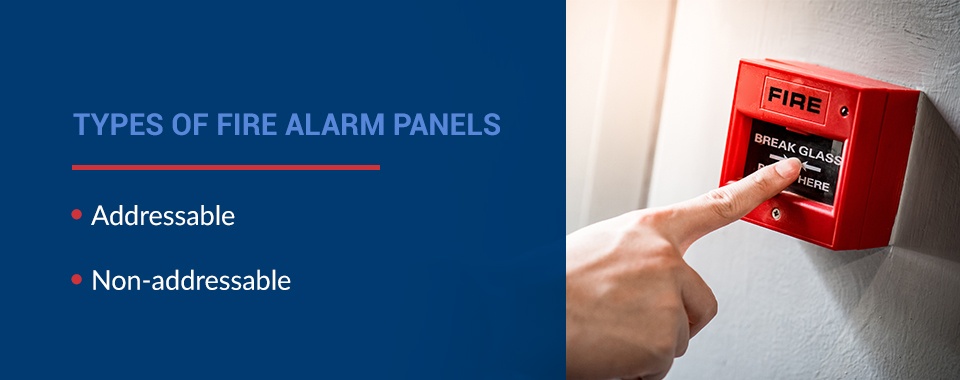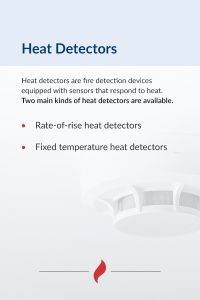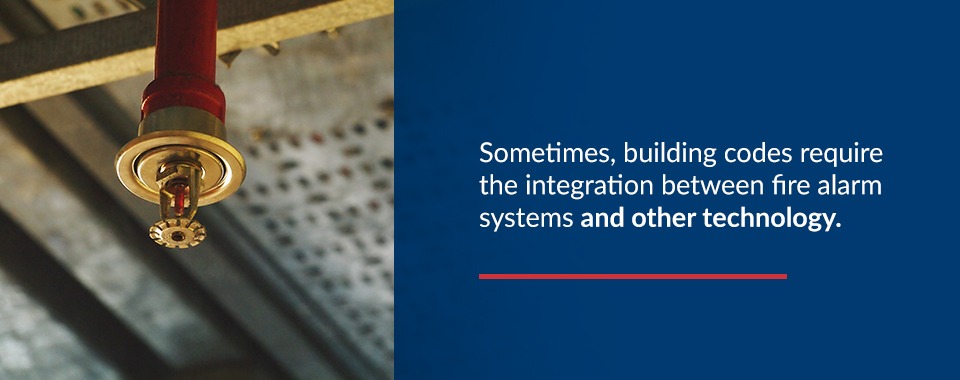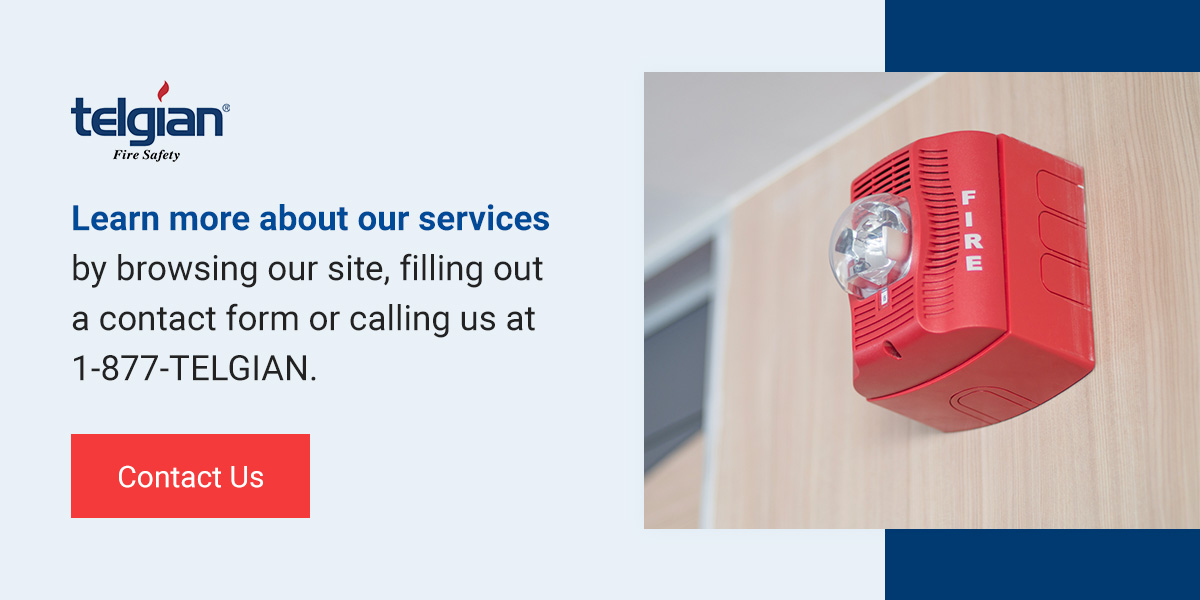A fire alarm system consists of various electronic devices that work together to detect and notify people of a fire or other emergency. Over the years, fire alarm systems have become increasingly sophisticated, so we’ve put together a guide to help you understand all the components of a fire detection alarm system and get the most out of this essential technology.
A Brief History of Fire Alarm Systems
Alarm systems have evolved considerably since Francis Robbins Upton, a Thomas Edison associate, patented the first automatic alarm system in 1890. Twelve years later, in England, George Andrew Darby developed the first heat and smoke detection systems, and in 1965, battery-powered smoke alarms first appeared. Since the 1980s, building codes have required the installation and use of battery-powered smoke alarms.
How Do Fire Alarm Systems Work?
A fire alarm system’s chief purpose is to detect fires and quickly notify both the occupants of the building and emergency services from a centrally controlled and monitored location. These systems also monitor themselves, identifying the location and origin of the alarms and sensing problems with connections and wiring that might prevent the system from working properly.
Fire alarms monitor around the clock and detect fires through initiation devices, like smoke and heat detectors. When the system detects these signs of a fire, it alerts occupants with a signal, which varies based on the system. The controlling function of a fire alarm system will then activate other systems like HVAC, Building Automation, clean agent systems and communicators to get in touch with local monitoring operations.
Ultimately, a fire alarm monitoring system is an advanced network of components that have defined jobs within the system. The moment fire risk is detected, these parts will act accordingly. Some parts of fire alarm systems exist to ensure other parts are doing their jobs. This extra layer of protection is critical for a system that alerts people to the need for emergency response.
Essentially, fire detection systems have four primary functions.
- Detection
- Notification
- Monitoring
- Controlling
These highly advanced systems use a network of appliances, devices and control panels to perform these four functions. To help you better understand the workings of an alarm system, we’ll discuss each component in detail below.
Components of an Alarm System
A fire alarm system consists of many components, including:
- Fire alarm control panel
- Initiation devices
- Pull stations
- Smoke detectors
- Duct detectors
- Heat detectors
- Beam detectors
- Air aspirating or air sampling smoke detectors
- Water flow switches
- Tamper switches
- Notification devices
- Audible devices
- Strobes
- Strobes/Horns
- Dialers or communicators
- NAC power supplies
Below we’re going to explain what each component does.
1. Fire Alarm Control Panel
The fire alarm control panel, commonly abbreviated as FACU, is the system’s “brain.” It receives messages from the initiating devices, also known as inputs, and performs the following functions.
- Turning on notifications: Upon receiving signals from the inputs, the FACU will turn on the necessary notification devices, also known as outputs. It alerts people in the vicinity that an issue has occurred.
- Elevator recall: The FACU also recalls elevators, which eliminates the possibility of an elevator delivering people to a flame- or smoke-filled area.
- HVAC system shutdown: If they detect smoke in an air duct, many fire alarm systems will shut the air handling unit down, thus preventing smoke from spreading to other parts of the building.
- Notifying alarm monitoring center: The FACU will also alert a remote alarm monitoring station, which, in turn, will notify emergency services.
Minimizing False Alarms
A poorly designed or installed fire alarm system that doesn’t get routine maintenance, testing and inspection will likely go off even when there’s no genuine danger. Frequent false alarms will cause people to take them less seriously. When hearing a fire alarm, many people assume it’s no cause for concern unless they also smell smoke or see flames.
To minimize the incidence of false alarms, the fire alarm industry has pushed for proper system design, installation, testing, maintenance and inspection.
Types of Fire Alarm Panels
The types of fire alarm systems include addressable and non-addressable.
- Addressable: Addressable panels monitor all alarm components individually. Each device comes with a distinct, separate address, which allows the panel to know their status, such as whether it’s functioning normally, in alarm or in trouble. For instance, addressable systems allow those working at a hotel’s front desk to know the exact location of the event by looking at the alarm panel display.
- Non-addressable: This type of system puts all initiating devices in zones, meaning users physically have to check each device in that zone to find the one in alarm. For instance, if you have a non-addressable system and the alarm goes off, it would tell you something like “Alarm Zone 3, Fourth Floor.”
Most property owners and managers prefer addressable systems, as they let you know the specific location of the alarm and assess the situation much more quickly. Some fire alarm panels can also notify remote alarm monitoring stations, which can then contact emergency services. Most state laws do not allow the panels to directly contact fire departments.
The Three States of a Fire Alarm System
Fire alarm panels continuously monitor and indicate the state of the fire alarm system. For the majority of systems, there are three possible states.
- Normal: “Normal” means that all appliances, devices, circuitry and wiring are functioning correctly and that there are no active alarms.
- Alarm: This status indicates an active alarm.
- Trouble: If an open or short wiring develops in the circuits that connect the initiating devices and the fire alarm panel, or if the system’s phone line connection isn’t working, the system will go into a “trouble” state, which the control panel will display.
2. Initiation Devices
Initiation devices initiate alarms, and, just like alarm panels, they can be either addressable or non-addressable. Some initiation devices, like water flow switches, are traditionally non-addressable, but connect with addressable modules. The switches can have specific addresses that let them communicate with addressable systems.
There are many types of initiation devices. In addition to water flow switches, initiation devices can also be:
- Pull stations
- Duct detectors
- Smoke detectors
- Beam detectors
- Heat detectors
- Tamper switches
- Air aspirating detectors
3. Pull Stations
A pull station is probably the fire alarm system component you’re most familiar with. It’s a manually operated device that initiates an alarm signal when someone pulls its handle. While smoke may take a few minutes to reach a smoke detector, you can activate a pull station within just a few seconds of a fire or other emergency, which allows for a quicker evacuation and faster reaction times by the fire department. Pull stations are available in various sizes and shapes and can come with protective covers upon request.
4. Smoke Detectors
A smoke detector is a device that initiates an alarm signal when it senses smoke. There are two classifications of these devices, depending on the type of sensor they use to detect smoke particles.
- Ionization detectors: These detectors contain tiny traces of radioactive material between two electrically charged plates. Ions flow between these two charged plates, but smoke particles disrupt this. If this happens, the smoke detector goes off.
- Photoelectric detectors: Photoelectric detectors emit LED light beams in their detection chamber. When smoke particles come into this chamber, they scatter the beam of light, deflecting part of it on the detector’s photoelectric sensor. When the sensor detects this light, the alarm goes off.
5. Duct Detectors
Duct detectors are smoke detectors installed in air conditioning and heating ducts. They shut air handling units down, preventing smoke from traveling all over the building via the air ducts.
6. Heat Detectors
Heat detectors are fire detection devices equipped with sensors that respond to heat. Two main kinds of heat detectors are available.
- Rate-of-rise heat detectors: This type of heat detector will respond if the temperature increases at a rate that exceeds a specified value.
- Fixed temperature heat detectors: Fixed temperature heat detectors will respond when their operating elements reach or exceed a predetermined temperature. There are two types of fixed temperature detectors: linear detectors, which monitor the temperature throughout an area, and spot detectors, which monitor the temperature in one specific location.
7. Beam Detectors
This kind of smoke detector projects a beam of light across the area it’s protecting. The beam points toward a reflector that returns the light signal back to the transceiver unit or a receiver. If smoke crosses the path of the beam, it disrupts the light signal and indicates that a fire is present. The detector will respond to this change by setting off an alarm or other indicator.
Beam detectors are best used in wide open areas like shipping warehouses, sporting arenas and concert halls, as they have wider coverage than other alarm types and can accurately discern between smoke and other types of obstructions.
8. Air Aspirating or Air Sampling Smoke Detectors
This type of detector uses tubes to deliver air or smoke to a central detector equipped with a sensor that can detect minute changes to the air’s chemical composition. These detectors are usually highly sensitive and can detect the risk of fire at its earliest stage.
Air sampling smoke detectors may have a couple of configurations for intaking and testing air. These systems are:
- Filtered: A fan draws air through a pipe system and a dual-stage filter, where dirt and large particles are removed. This process enables sensitive detection of smoke particles.
- Particle counting: After drawing in air, the system uses a laser beam and photo collector to measure reflected light from the particles. The system uses the number of discrete particles to identify smoke concentration.
9. Water Flow Switches
Water flow switches use paddles located inside water-filled piping that will respond if water flows. On sprinkler systems, their design allows them to work if water is flowing from only one sprinkler. The alarm system activates and controls water flow when a fire is detected, and the flow switches ensure the sprinklers work throughout the entire pipe network.
10. Tamper Switches
A tamper switch is a supervisory initiating device that operates if someone moves its valve from its regular position. Tamper switches are essential to sprinkler networks because they ensure the piping valves are in the proper position to allow water to flow through the pipes. If a valve closes, the water cannot flow to suppress the fire or activate the fire alarm. The tamper switch alerts facilities managers to the closed valve so it can be reopened and ready to allow water to flow.
11. Notification Devices
These devices send a visual or audible notification to alert a building’s occupants to evacuate. This broad category of devices encompasses of few different types of notification systems. Some alarm systems may use a combination of notification types, while others only use one.
12. Audible Devices
Audible devices include sirens, bells, speakers and horns.
13. Strobes
Strobes send notifications by flashing a light.
14. Strobes/Horns
These devices send notifications by flashing a light and blaring a siren or live/recorded voice messages to alert people to respond.
15. Dialers or Communicators
Some fire alarm systems have internal or external dialers used to contact monitoring centers or alarm receiving stations. Communicators can use radio signals, phone lines or an internet connection to maintain contact. Panels may have built-in dialers or communicators. Dialers or communicators can remove a step from fire response plans, as facilities will not need to contact a fire crew while exiting the building.
16. NAC Power Supplies
Today’s systems require many notification devices, which need extra power supplies known as notification appliance circuit power supplies or NAC power supplies. You can find these by the main panel or distributed around the building as needed.
How Do Fire Alarm Systems Integrate With Other Life Safety Technology?
Sometimes, building codes require the integration between fire alarm systems and other technology. However, in other cases, integration is optional and voluntary, such as integration with lighting systems, HVAC systems, door locks and security systems. While these systems have historically needed independent network communications, they can now operate on a shared infrastructure, saving you money and streamlining processes.
Some examples of functions and systems commonly interfaced with fire alarm systems are:
- Extinguishing systems such as automatic sprinkler systems
- Power interruption and elevator recall
- Smoke management
- HVAC fan and damper controls
- Door unlocking and door release
- Security systems
- Mass notification systems
- Monitoring of fire extinguishers
According to the National Fire Alarm and Signaling Code, some of the above are “fire safety functions” meant to improve occupants’ life safety or control the spread of fire. You can choose to integrate other functions or systems for various reasons, such as for their operational benefits, information sharing and cost savings.
How Often Do You Need to Inspect Fire Alarms?
Inspecting and testing fire detection equipment is critical for occupant safety. These systems operate in the background, so it can be challenging to notice when a component no longer functions as it should. The only time you’d notice these equipment failures is during a fire. Keep your facility safe and prepared by abiding by all regulatory standards for inspections.
You can learn about the requirements for inspecting, testing and maintaining fire alarm systems, including their notification appliances and initiating devices, in Chapter 14 of NFPA 72 ‘National Fire Alarm and Signaling Code’. However, we will summarize these requirements below.
Visual Inspections
You should have the components of your fire alarm visually inspected every week, month, six months or once per year, according to NFPA 72’s schedule in table 14.3.1. However, these schedules can vary depending on your local laws, as well as the authority-having jurisdiction. Standard visual inspections include the following.
- Control equipment: Check this every week to confirm the system is working correctly. That includes inspecting the LEDs, power supply, fuses and seeing if there are any trouble signals.
- Batteries: Depending on the type of batteries you have, you need to check them either once or twice a month for leakage and corrosion.
- Heat detectors, duct detectors and smoke detectors: Check these semiannually.
You must inspect all equipment yearly to confirm there aren’t any changes affecting its performance.
Testing
Testing components involves more steps than visual inspections, but it’s unnecessary to do it as often. Though several components require semiannual testing, most components only need once-a-year tests, according to NFPA 72’s table 14.4.3.2. Like with inspections, your testing schedule can vary depending on your local laws and authority-having jurisdiction. Here are some examples of component testings.
- Control equipment: You must test this once a year to confirm proper receipt of alarm, supervisory and trouble signals.
- Control unit trouble signals: You must check and verify both visual and audible trouble signals annually.
- Secondary power supply: Test this by unplugging all your primary power supplies.
- Initiating devices: You must test these to ensure they’re operating as intended and are transmitting the signal to your control unit. That means you should test your smoke detectors with smoke or an acceptable smoke simulant, and your heat detectors must have a heat test. Testing for these devices should be conducted quarterly.
- Alarm notification appliances: You must visually and audibly test and verify that these are working correctly.
- Batteries: Alarm system batteries must be tested monthly. Testing methods depend on the battery types. Lead acid batteries need a 30-minute discharge test and a load voltage test. Sealed lead acid batteries need a charger test in addition to these two tests. Batteries in central station facilities must be tested quarterly.
Maintenance
You must maintain the components of your fire alarm system according to the instructions published by your manufacturer. How frequently you perform maintenance depends on environmental conditions, as well as the kind of equipment you have. How you clean your system components depends on their location and the manufacturer guidelines.
When installing a new fire alarm system, read the operator’s manual to learn about maintenance processes and how frequently you need to perform them. Create a schedule for your facility so facilities managers always know when the system is due for maintenance.
Contact Telgian
For the past 35 years, Telgian has been providing innovative solutions for clients worldwide. Learn more about our services by browsing our site, filling out a contact form or calling us at 1-877-TELGIAN.




